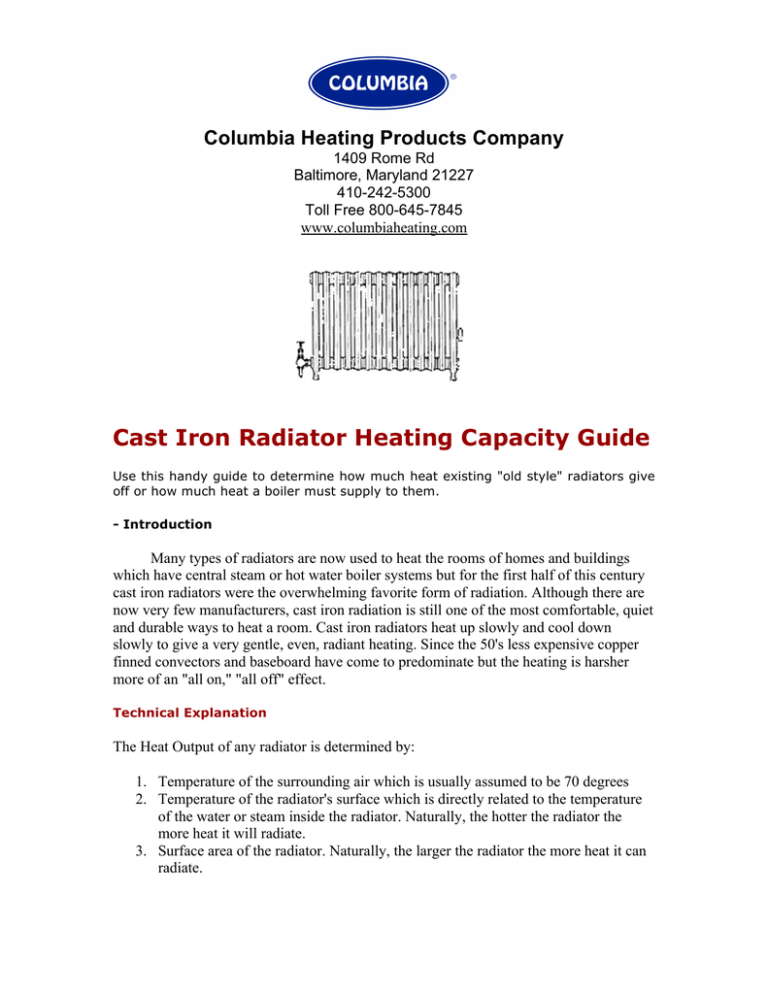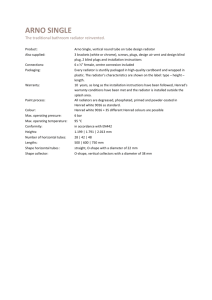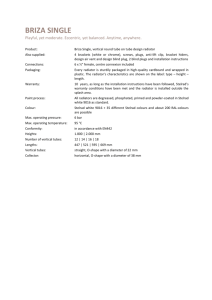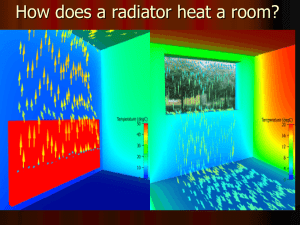Cast Iron Radiator Heating Capacity Guide
advertisement

Columbia Heating Products Company 1409 Rome Rd Baltimore, Maryland 21227 410-242-5300 Toll Free 800-645-7845 www.columbiaheating.com Cast Iron Radiator Heating Capacity Guide Use this handy guide to determine how much heat existing "old style" radiators give off or how much heat a boiler must supply to them. - Introduction Many types of radiators are now used to heat the rooms of homes and buildings which have central steam or hot water boiler systems but for the first half of this century cast iron radiators were the overwhelming favorite form of radiation. Although there are now very few manufacturers, cast iron radiation is still one of the most comfortable, quiet and durable ways to heat a room. Cast iron radiators heat up slowly and cool down slowly to give a very gentle, even, radiant heating. Since the 50's less expensive copper finned convectors and baseboard have come to predominate but the heating is harsher more of an "all on," "all off" effect. Technical Explanation The Heat Output of any radiator is determined by: 1. Temperature of the surrounding air which is usually assumed to be 70 degrees 2. Temperature of the radiator's surface which is directly related to the temperature of the water or steam inside the radiator. Naturally, the hotter the radiator the more heat it will radiate. 3. Surface area of the radiator. Naturally, the larger the radiator the more heat it can radiate. A radiator's relative radiating surface area is measured in terms of Square feet of "Equivalent Direct Radiation" or "EDR". There are two types of hydronic heating systems which utilize cast iron radiators: • • Hot water heating systems circulate water heated by a boiler up through the radiators. The water can be mechanically pushed by a circulating pump or the system may have been designed to take advantage of the fact that hot water rises because it is less dense than "cold" water. The latter are called gravity hot water heating systems. Most of these systems were designed to deliver no more than 180 degree water to the cast iron radiators. Steam heating systems for homes make & use steam at very low pressures, usually under 1 pound per square inch. Steam rises naturally and quickly from the boiler up to the radiators. When a radiator is filled with this low pressure steam it can reach a temperature of 215 degrees Fahrenheit. As mentioned above (#2) and as the following chart shows a radiator's heat output is directly related to its temperature: In most cases a Square foot EDR of radiation will emit 240 BTUs per hour on steam heating systems or 170 BTUs per hour on hot water heating systems. This "rule of thumb" proves reliable for cast iron radiators as applied in existing homes in the United States. The above graph shows that these outputs will be higher or lower if the steam or water within them is hotter or cooler. It will also vary if the radiators are exposed to blowers or fans and if they are covered or obstructed. Okay, that's how much heat each square foot of Equivalent Direct Radiation can be expected to emit in normal home heating design so then... The TOTAL of the Square feet EDR ratings of all the radiators in a house multiplied by either: • • 170 BTUs per hour if its a hot water based system or 240 BTUs per hour if its a steam system is how much heat the boiler in the house must deliver to make all of those radiators hot. Usually that's more than enough heat to keep the house warm - even on the coldest day and even enough to dry everyone's wet mittens at the same time! In fact, when they were built most houses with cast iron radiators weren't very well insulated and often didn't have storm windows. Since then many have had energy saving improvements so the total radiator heating capacity is now much greater than the minimum needed according to the building's actual heat loss. It is, however, very comforting to really "cook" all those radiators on bitter cold days. Replacement steam boilers must have enough power to fill every radiator with steam but replacement hot water boilers for the improved home can be selected according to the actual heat loss instead of radiator heating capacity if the residents can accept the lower water and radiator temperature which will result. This all sounds pretty simple, huh? Well it is, the only trick is determining the EDR square footage for each radiator. Cast Iron Radiator Heating Capacity Guide - Looking at a Radiator There are three general classifications of radiators found in older homes: Column Type, Tube Type and Wall Type. More recently cast iron 9" tall baseboard has been available. First, this guide will demonstrate how to identify and find the EDR ratings for floor standing column and tube type radiators which are what most of us think of first when we think of "radiators". Wall type radiators will be discussed afterwards. Column Type Tube Type Wall Type A traditional cast iron column or tube type radiator is described and measured in terms of: 1. HEIGHT in inches 2. Number of SECTIONS As you stand in front of a radiator it almost looks like a loaf of bread. Each cast iron slice is called a section. 3. Number of TUBES or COLUMNS. As you look at a radiator from the narrow end you can tell that each of the above slices or sections is made up of 1 or more vertical columns or tubes. The real old ones are about 2 1/2" wide and they are called COLUMNS. In "newer" radiators these vertical cast iron pipes are only about 1 1/2" wide and are called TUBES Right! We really don't care about a floor standing radiator's overall width or depth. So go ahead. Jot down the number of tubes and sections and the height of every radiator. 5 Tubes, 7 Sections 2 Columns, 7 Sections Check the next page's table to get the Square feet EDR of one section of each radiator. Then multiply that by the number of sections in the radiator and you'll have the Square Foot EDR rating of that radiator. Multiply that total by either 170 Btus per hour (hot water systems) or 240 BTU’s per hour (steam systems) to get the design heating capacity of that one radiator. Do the same for all the radiators in that system. The sum of all these heating capacities is a home's total radiation heating demand on its boiler. Cast Iron Radiator Heating Capacity Guide - EDR Ratings and Square Feet Per Sections Column or Tube Type Radiator EDR Chart (# of tubes/height) 13" 16" 18" 20" 22" 23" 26" 30" 3.00 3 Tubes 1.72 2.00 2.33 4 Tubes 2.25 2.50 2.75 5 Tubes 2.67 3.00 3.50 6 Tubes 3.00 3.50 4.00 7 Tubes 2.60 3.50 4.20 1 Column 36" 38" 3.50 3.50 3.50 4.25 4.33 5.00 45" 6.00 5.00 4.75 1.50 2 Cols. 4.33 32" 2.00 2.50 3.00 2.33 2.67 3.33 4.00 5.00 3 Cols. 2.25 3.00 3.75 4.50 5.00 6.00 4 Cols. 3.00 4.00 5.00 6.50 8.00 10.0 7.00 8.50 10.0 5 Cols. 2.00 1.67 3.00 3.75 4.50 5.00 6.30 1. Find the Sq. Ft. EDR per section above 2. Multiply by the number of sections altogether in that radiator to get Sq. Ft. EDR for the entire radiator 3. Multiply by 240 BTUs per hour to get the steam design output or Multiple by 170 BTUs per hour to get the hot water design output Forgot how to identify & measure radiators? Wall Radiator EDR Ratings All wall radiator may be composed of one or more flat wall hung sections. Each section can be best identified by measuring in inches its height, its width and its depth or thickness. Jot down those measurements then use the following chart to find the Square feet EDR of the section closest to those dimensions. Height Width Thickness EDR 13" 15 5/8" 2 7/8" 5 13" 21 7/8" 2 7/8" 7 22" 13 3/16" 3 1/16" 7 18" 29 1/16" 2 7/8" 9 29" 18 5/16" 3 11/16" 9 Wall Radiator 1. Find the Sq Ft EDR per section above 2. Multiply by the number of sections altogether in that radiator to get Sq. Ft. EDR for the entire radiator 3. Multiply by 240 BTUs per hour to get the steam design output or Multiple by 165 BTUs per hour to get the hot water design output


